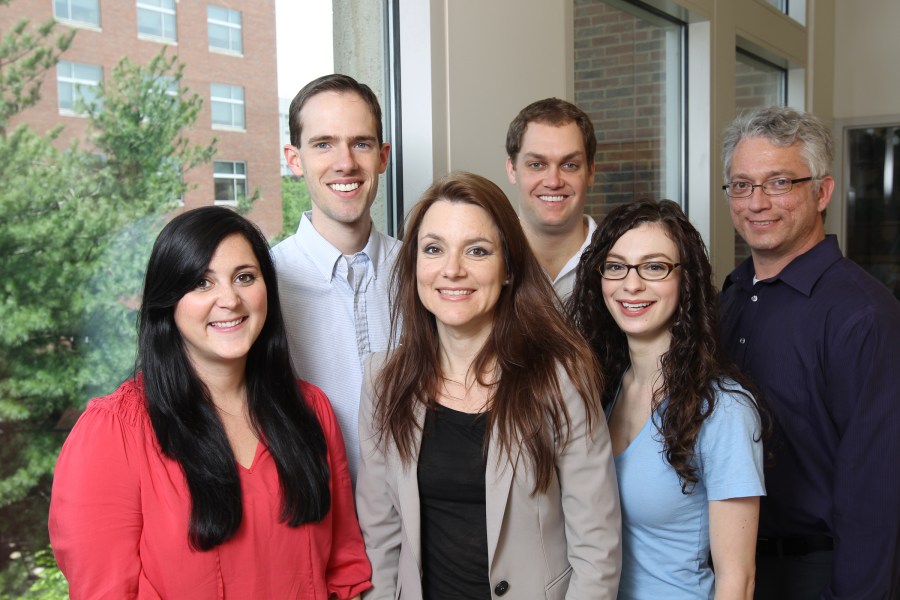
The winning team included (back row, from left) Will Ashby, graduate student in Chemical and Physical Biology, Terry Kirkley, MBA candidate, John Lowe, Ph.D., research fellow in Clinical Pharmacology, (front row, from left): Kelsey Duggan, Ph.D., research fellow in Biochemistry, Eva Harth, Ph.D., assistant professor of Chemistry, and Emily Rubinson, Ph.D., research fellow in Chemical and Physical Biology. (photo by Steve Green)
Science, business trainees join forces in name of invention
Trainees in science and business at Vanderbilt University have created a unique educational exercise at the increasingly important intersection of their fields.
The project challenges graduate students and postdoctoral research fellows, working with MBA and law students, to come up with ideas for bringing patented inventions by Vanderbilt faculty members to market.
Earlier this month, during the inaugural “TechVenture Challenge,” six teams presented executive summaries of their plans to a panel of judges at the Entrepreneur Center in Nashville.
The winner was a proposal to commercialize a nanosponge drug delivery system developed by Eva Harth, Ph.D., assistant professor of Chemistry.
Whether or not this idea or any of the others go forward, the exercise was a “real eye opener” for participants who previously had limited understanding of each others' worlds, said Mary Kosinski, Ph.D., of Vanderbilt's Office of Technology Transfer and Enterprise Development.
Judsen Schneider, Ph.D., a research fellow in the Vanderbilt Center for Stem Cell Biology, agreed. “The business side of science is a critical component to translate scientific discoveries into medicine,” he said. “This event helps provide that experience to students."
TechVenture Challenge emerged from discussions Schneider had with three other Vanderbilt research fellows, Greg Digby, Ph.D., Tim Panosian, Ph.D., and Tom Utley, Ph.D., and with Andy Rigby and Hannah Johnson, MBA candidates in the Owen Graduate School of Management.
With the help of Kosinski and a faculty advisory committee, they recruited Harth and five other Vanderbilt inventors: Michael Barnett, M.D., (Cardiovascular Medicine); James Crowe Jr., M.D., (Vanderbilt Vaccine Center); Al George, M.D., (Genetic Medicine); and Michael Goldfarb, Ph.D., and Robert J. Webster III, Ph.D., (Mechanical Engineering).
During a first session in late February, the faculty members discussed their inventions and teams formed to develop ideas for commercializing them.
A five-member panel of judges, including local entrepreneurs, business professors and an intellectual property lawyer, was assembled to hear the presentations, issue critiques and select the one most likely to succeed.
The winning proposal speculated that an initial $400,000 investment would be needed to develop and test Harth's nanosponge technology before it hopefully could be sold to a pharmaceutical company.
“This may have real value,” said Joseph Cook Jr., a former Eli Lilly & Co. executive and co-founder of Limestone Fund LLC, a TNInvestco fund, on behalf of his fellow judges.
“You have produced results in animals that are hopefully translatable directly into humans,” Cook said. If the sponge can find and attach itself to cancer and other target cells, then slowly release its cargo of drug as designed, “we think it may have a very broad application to a wide range of medicines,” he said.
“I would never have envisioned this,” Harth said about the idea developed by her team of three postdoctoral fellows, a graduate student and an MBA candidate. “You need these kinds of people who build a real synergy to get the idea out there.”













